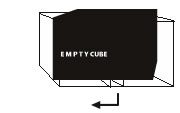MANUEL MOTA
SEPTEMBER, 14, 2010

CONTACTS
headlightsrecordings@gmail.com
EXHIBITION INFORMATION
DIA DA RAREFAÇÃO E RUMOR DA DISTÂNCIA
video c.60”
With the collaboration:
David Maranha, Gabriel Ferrandini, Riccardo Dillon Wanke
The rarefaction of distance.
Manuel Mota’s project for EMPTY CUBE, ‘dia da rarefacção e rumor da distância’ [‘rarefaction day and murmur of distance’], reformulates the original connection between the event’s duration and its performative component, in the wake of previous projects that had tackled and achieved similar actions, thus contributing towards redefining the features of this ephemeral project.
However, the work Mota brought here, in collaboration with three musicians: David Maranha, Gabriel Ferrandini and Ricardo Dillon Wanke, has dilated, so to say, the experience enjoyed by each of the visitors. This dilatation, or increased amplitude, stems from the piece the artist and his collaborators created during the space of sixty minutes, using image and sound to convey extracts of an immersive universe that demands the viewer’s full engagement. This engagement is triggered via the concentration of a variety of elements, scattered across several different spaces, from the cube in which the event is held and the, sometimes invisible, space enveloping it, to the space inside the sequence of video images, all combining into a unique piece of work that develops itself in accordance with a singular metre.
The work’s performative character does not reside in the action taking place before us, but instead in its appeal to our ability to allow our body to receive the murmur of sounds that emanate from the cube’s space, while letting our attention roam over the imprecise and apparently motionless images.
The beginning of the piece contains elements that give us brief clues regarding the start of our itinerary. The first sentence, ‘Dia da visita críptica’ [‘Cryptic visit day’] reminds us of the work’s title and is also the (residual) beginning of other ‘days’ that follow one another in this narrative where time and motion become condensed, inviting viewers to immerse themselves in the acoustic and visual environment.
The work opens with the following sentences on a black background:
‘Dia da visita críptica’ [‘Cryptic visit day’]
‘Contorna harmoniosamente a escarpa antes da imersão’ [‘Harmoniously goes around the cliff prior to immersion’]
‘anestésica e pacificadora’ [‘anaesthetic and pacifying’]
Together with these words, chords from acoustic instruments are heard, apparently reaching us from within the cube’s space, preceding a visually identifiable landscape, played in slow motion, as if it were a nearly static image. Similarly, the sentences’ black background becomes also an image, almost a visual field, during the video projection, as if it were an image of the abstraction of the visible.
The rapport between the succession of visual spaces in the video projection and the sound played in the event’s physical space (the cube) seems concentrated in a single device. This apparent and inscrutable element weaves a web of relationships between a variety of visible, non-visible, resounding, felt or imagined spaces, inviting us to take part in a process where temporality is measured in terms of the work’s development, with the a priori knowledge that the work’s duration is limited and unrepeatable. In a certain way, the experience’s possibility and its conditions are also defined by the performance in real time of the work’s musical component, even though that action takes place away from our sight. Nonetheless, it can be felt, being thus closer to home as an experience.
João Silvério
October 2010



